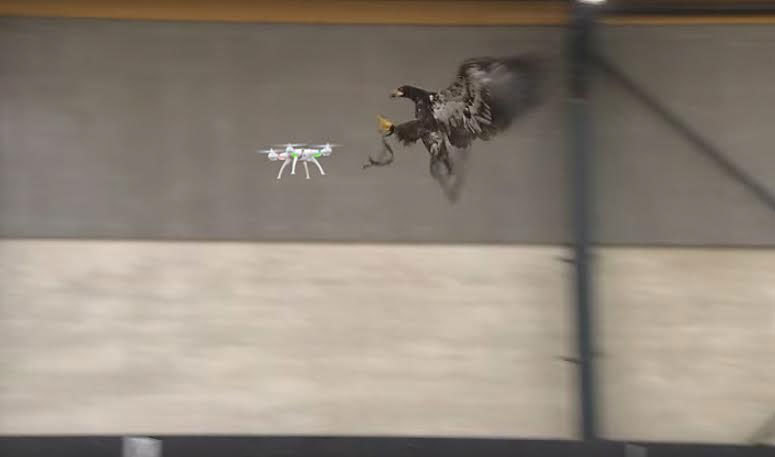
Spotted by The Mercury News, it’s designed for “densely populated” areas. The tower allows drones to fly in and out, acting like a giant beehive, with robotic arms that help snatch them out of the sky. Inside, the core features layers of spokes around one central hub. The spokes are specialized for various purposes, like repairing the drones, or loading them with goods. — Fast Co. Design
Amazon has been experimenting with the use of delivery drones for some time now though this approach to shipping has yet to take off for the e-commerce giant. As they continue testing this prospective delivery method, it is clear the retailer takes the particular vision quite seriously. On Thursday, the company filed a patent with the US Patent and Trademark Office for a drone tower that would essentially be a multi-level fulfillment center for unmanned aerial vehicles.

It's a strategy worth noting- using a patent to transform the building into a product- thus eliminating the need for "architecture" and Amazon maintains complete control over the aesthetic. Yes, it's nothing more than a distribution center, but that banal type actually works in Amazon's favor. It's an evolutionary product of the Butler building, with an exclusive touch.
"Duh" is the immediate response, but imagine if this becomes a visible precedent? Imagine how they would transform the landscapes around them ecologically (I'm imagining the first locations these will pop up will be in rural locations, places where architects "seem" to not care about buildings- thus creating quiet leverage)?
More directly, how will they impact existing architecture types (think distribution centers along highways along major highways)? Architecture has already been affected by these industrial design based solutions. One of the health care providers in my region has a mobile MRI unit and the architecture is designed to accommodate it.
In short, I think it's something to watch carefully. The suggestion that building can be a patent, thus escaping the need for architectural considerations is a dangerous one, both professionally and environmentally. This truly is something that the AIA ( and ASLA) should be addressing.
All 7 Comments
It's a strategy worth noting- using a patent to transform the building into a product- thus eliminating the need for "architecture" and Amazon maintains complete control over the aesthetic. Yes, it's nothing more than a distribution center, but that banal type actually works in Amazon's favor. It's an evolutionary product of the Butler building, with an exclusive touch.
"Duh" is the immediate response, but imagine if this becomes a visible precedent? Imagine how they would transform the landscapes around them ecologically (I'm imagining the first locations these will pop up will be in rural locations, places where architects "seem" to not care about buildings- thus creating quiet leverage)?
More directly, how will they impact existing architecture types (think distribution centers along highways along major highways)? Architecture has already been affected by these industrial design based solutions. One of the health care providers in my region has a mobile MRI unit and the architecture is designed to accommodate it.
In short, I think it's something to watch carefully. The suggestion that building can be a patent, thus escaping the need for architectural considerations is a dangerous one, both professionally and environmentally. This truly is something that the AIA ( and ASLA) should be addressing.
And another take-
"denial of service" attacks will take on an entirely new meaning.
This looks like influence or convergent evolution.
https://www.future-firm.org/dr...
Chris, I hear you.
The position I am taking here is not that a building like that would drown in paperwork in an urban environment, but Amazons goal is to have people understand if as it's that it's no longer a building. And here are three other things to think about.
1- Walmart and Target: two big box brands that used their suburban and exurban locations to create highly sophisticated networks and a stranglehold on urban markets as the people grew up and moved to cities. Eventually, they had urban models in place to fill those needs.
2- You don't need to be in the urban core with a drone network. Think of a fleet of drone crossing the Hudson from New Jersey. Think of the "jobs and revenue created (smoke)," with a lessened need to deal with ground traffic to get goods to the tower.
3- And think about carrier hotels, and how they create these surreal spaces based on the "ecology" of high-speed digital networks- carrier hotels being informational ecotones. They're in buildings, but they've certainly done their best to transform the interior into an architecture for others.
In my airspace I shoot drones on sight.
It's a simple VOTE-WITH-YOUR-DOLLARS / Vote-with-your-feet idea....
All the "SHEEP" who use AMAZON for EVERYTHING, because, well, they are lazy, cheap SHEEP... simply need to STOP using Amazon. They will fall into the black hole of the past with a whimper and take all their asinine horse-$hit "Patents" with them. Simple. Occam's f-ing Razor simple. But will the SHEEP do it?
The amount of pretentiousness in this thread is making my eyes bleed.
Block this user
Are you sure you want to block this user and hide all related comments throughout the site?
Archinect
This is your first comment on Archinect. Your comment will be visible once approved.